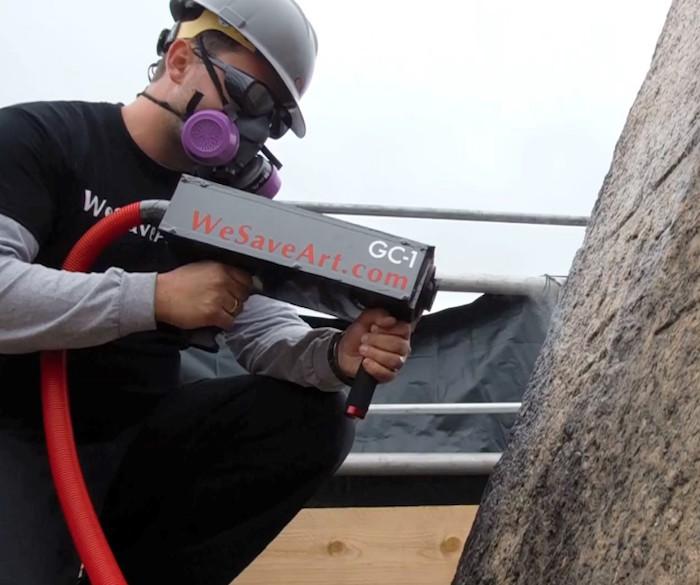
Crews will attempt to remove the coating of "biofilm" on the Jefferson Memorial in Washington with a laser treatment/NPS
The National Park Service is preparing to begin a test an experimental laser removal treatment of the biofilm affecting the Thomas Jefferson Memorial, most evident on the dome. The project will clean a test area of 1,000 square feet on the northeast side of the memorial that will allow the National Park Service to evaluate the effectiveness of the technique. The results of this cleaning test will be used to determine how the remainder of the biofilm on the memorial’s dome and pediment might be cleaned.
The blackening effect of biofilm, a colony of microscopic organisms that adheres to stone surfaces, was first noticeable in discrete areas of the memorial’s white marble in 2006, and has become more pronounced in recent years. A multi-disciplinary team of conservators, architects and other professionals has been studying the growth on the Jefferson Memorial since 2014 to determine the best treatment options.

Testing begins next week on a special laser approach to removing biofilm from the dome of the Jefferson Memorial/NPS
Since announcing the search for a successful cleaning method in August 2016, the National Park Service has reviewed hundreds of potential products and processes, considering not only their effectiveness on the biofilm, but also how they might impact the memorial’s historic stone and the surrounding natural environment.
Laser ablation offers maximum protection to both the memorial’s cultural and natural resources: by fine-tuning the laser settings to the specific stone and soiling types, the specially trained laser operators can remove the biofilm without damaging the historic marble of the memorial, a Park Service release said. The use of laser is also an environmentally sound procedure and eliminates the need to use more aggressive chemicals or abrasive cleaning methods. Rigorous safety controls will be maintained for the duration of the cleaning process to protect the public and the operators.
The laser ablation test is being conducted by Conservation of Sculpture and Objects Studio, Inc., a Chicago-based conservation company. The treatment is expected to begin next week and take approximately four weeks; the results should be immediately noticeable. Scaffolding is being erected on the northeast side of the memorial dome to allow the conservators to reach the test area, but visitor access to the memorial will not be affected.

The process is supposed to be quick and should not damage the marble. The GC-1 laser was custom-built to clean the 3,500 year old Egyptian obelisk Cleopatra’s Needle in New York City’s Central Park/NPS



Comments
great technology, what was the cleaning speed ?